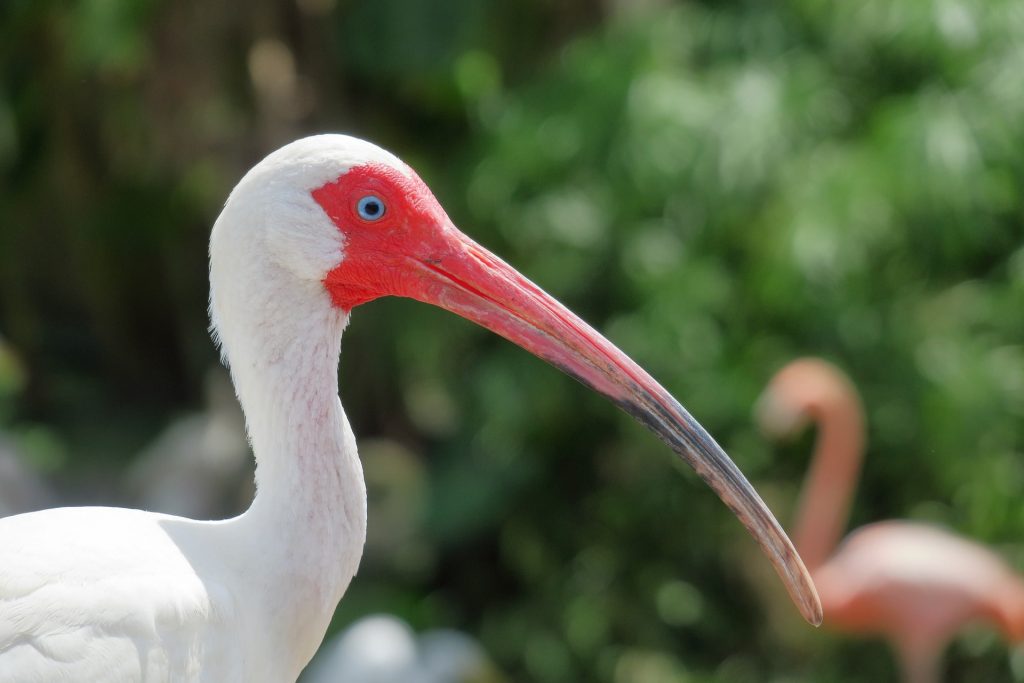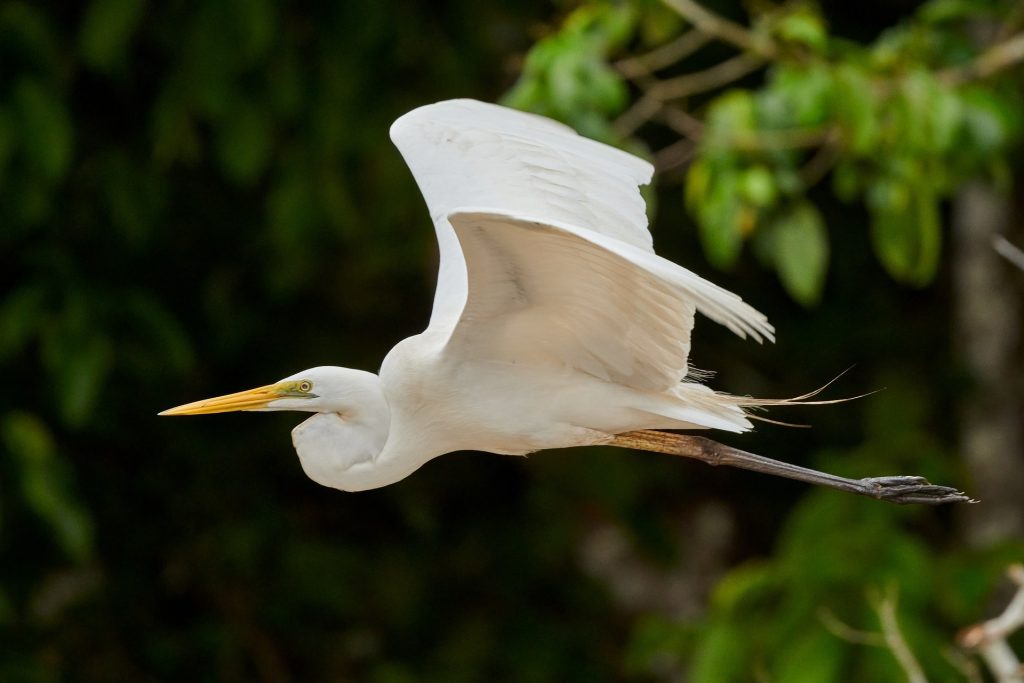All about Birds
White Birds in Florida with Long Beaks
There are many birds that can be found in the Sunshine State. From the ever-present white ibis to the more exotic snowy egret, Florida is a bird lover’s paradise. In this state there are over 400 bird species and below, we’ll niche down to white birds in Florida with long beaks.
While some birds are only found in certain parts of the state, others can be seen all over.
No matter where you go in Florida, you’re sure to see some amazing birds. So, before you head outdoors, let’s add a few names to your birding wish-list.
1. White Ibis

Scientific Name: Eudocimus albus
Wingspan: 41 inches
Lifespan: 16 years
The white ibis is an amazing bird species of ibis that is found all-year round in Florida. The bird is a member of the family Threskiornithidae, which includes the spoonbills. This Florida bird with long beak gets its name from its white plumage, which is most visible during the breeding season.
Their legs and bill are red in plumage, with the bill averaging 6.6-7.1 inches long. The bird’s diet consists mostly of invertebrates, and it can often be seen wading in shallow water in search of food.
The white ibis breeds in colonies, and the birds often build their nests in trees or shrubs near water. The female lays three to five eggs, and both parents help to take care for the young.
2. Great Egret

Scientific Name: Ardea Alba
Wingspan: 67 inches
Lifespan: 5 Years
Another type of white bird in Florida with long beak is the great egret. These birds are known for their long necks and legs, and their bright white feathers.
They also have long dagger-like yellow bills that make them great hunters. They often eat small fish, amphibians, reptiles, and insects. Great Egrets are not only good hunters, but they are also excellent swimmers.
They have been known to swim long distances to reach their nesting sites. Great Egrets are very social birds, and they often live in colonies with other egrets.
They are found across Florida and the best time to see them is between March and April. They favor freshwater and saltwater territories.
3. Whooping Crane

Scientific Name: Grus americana
Wingspan: 87 inches
Lifespan: 24 inches
The whooping crane is one of the most endangered birds in Florida. These white birds of Florida are tall, 4-5 ft, with long necks and legs.
The adult is white overall with black wingtips, dark feet and bill. Cranes mate for life and build nests in trees near bodies of water. They prefer eel, mollusks, aquatic insects, snails and berries. They are named for their loud calls, which can be heard up to two miles away.
Whooping cranes were once abundant throughout Florida. However, hunting and habitat loss led to a drastic decline in their numbers. In 1941, there were only a few whooping cranes left in the wild. Thanks to conservation efforts, their numbers have slowly increased. However, they are still at risk of extinction.
4. Wood Stork

Scientific Name: Mycteria americana
Wingspan: 71 inches
Lifespan: 18 years
A wood stork is a large wading bird with a long, thick bill. It is a member of the genus Mycteria. This large white bird is found in subtropical and tropical regions of the Americas, from Florida and Cuba to Brazil and Argentina. They are generally found near bodies of water, such as lakes, swamps, and rivers.
An adult boasts of a span of up to 71 inches and is white overall. Note the black flight feathers. Their bills are thick and curved, ideal for scooping up fish from shallow waters. Wood storks eat mostly fish, but they will also consume amphibians, reptiles, and small mammals.
See Also: Introducing The Orange-Beaked Bird
5. American White Pelican

Scientific Name: Pelecanus erythrorhynchos
Wingspan: 120 inches
Lifespan: 25 years
The American white pelican is a large bird with a wingspan of up to 10 feet. They are mostly white with red-yellow bills. Notice the orange feet.
They are migratory birds, visiting Florida during winter months. Pelicans are very social birds and often live in large colonies near water. They eat fish, frogs, and salamanders. American white pelicans can often be seen swimming in groups, using their bills to scoop up fish.
These birds are interesting to watch as they go about their daily lives. If you’re lucky enough to see one, you’re sure to be impressed by its size and beauty.
6. Great Blue Heron

Scientific Name: Ardea herodias
Wingspan: 66 – 79 inches
Lifespan: 15 years
The Great Blue Heron is one of North America’s most recognizable and popular birds. Standing up to four feet tall, with a wingspan of nearly six feet, this white bird with long beak is an impressive sight.
The bird has two morphs. An adult can have powdery-blue coloring on their feathers with a black crown or have an all-white body with yellowish legs. Both morphs have a long yellowish-orange bill.
In Florida, they prefer the Southern part of the State. The bird prefers to live near water, and can often be seen wading in shallow ponds or stalking fish in deeper waters. The Great Blue Heron is an excellent hunter, capable of snatching fish from the water with its sharp bill.
7. Masked Booby

Scientific Name: Sula Dactylatra
Wingspan: 67 Inches
Lifespan: 20 Years
The masked booby is a seabird that gets its name from the black mask-like marking around its eyes. It is a large bird, with a wingspan of up to six feet. This white bird is found in tropical and subtropical regions, and breeds on islands in the Pacific and Atlantic oceans.
The masked booby is a curious bird, and will often approach humans who are on their boats or on the shore. They are not shy, and will even land on people! It is also known for being very vocal, making loud calls that can be heard from far away.
Despite their friendly nature, the masked booby is not without its predators. Large birds of prey, such as eagles and owls, will sometimes target them.
8. Snowy Egret

Scientific Name: Egretta Thula
Wingspan: 39.4 Inches
Lifespan: 16 Years
The Snowy Egret is a beautiful bird that is known for its white plumage. These birds are found in the southeastern United States, where they breed and nest.
The Snowy Egret is a member of the heron family, and it is closely related to the Great Egret. These birds are about two feet tall, with a wingspan of about 3.3 feet.
This bird of Florida has a long, thin neck and a black bill. Its legs are dark while the feet are a bright yellow.
The Snowy Egret feeds on fish, crustaceans, and insects. It uses its bill to spear its prey, or to scoop it up from the water. The Snowy Egret is a protected species, and its numbers have been declining in recent years.
9. Cattle Egret

Scientific Name: Bulbulcus Ibis
Wingspan: 38 Inches
Lifespan: 10 Years
Cattle Egret: A Bird that is both helpful and a Pest. Smaller than other egrets on this list, cattle egrets prefer warmer climates. They are helpful to farmers because they eat insects that harm farm animals. But the bird can also be a pest, pooping on cars and buildings.
The Cattle Egret is about two feet long with a wingspan of three feet. It has a yellow bill and long legs. The bird is mostly white with some orange on its head, back and breast during breeding season. Male and female birds look alike. You can spot them in Florida round the year.
Where to go birding in Florida
There are a few places you can go birdwatching in Florida. This are the top 7 spots:
- Corkscrew Swamp Sanctuary
- Dry Tortugas National Park
- Everglades National Park
- Myakka River State Park
- Great Florida Birding Trail
- Big Cypress National Reserve
- Apalachicola National Forest

